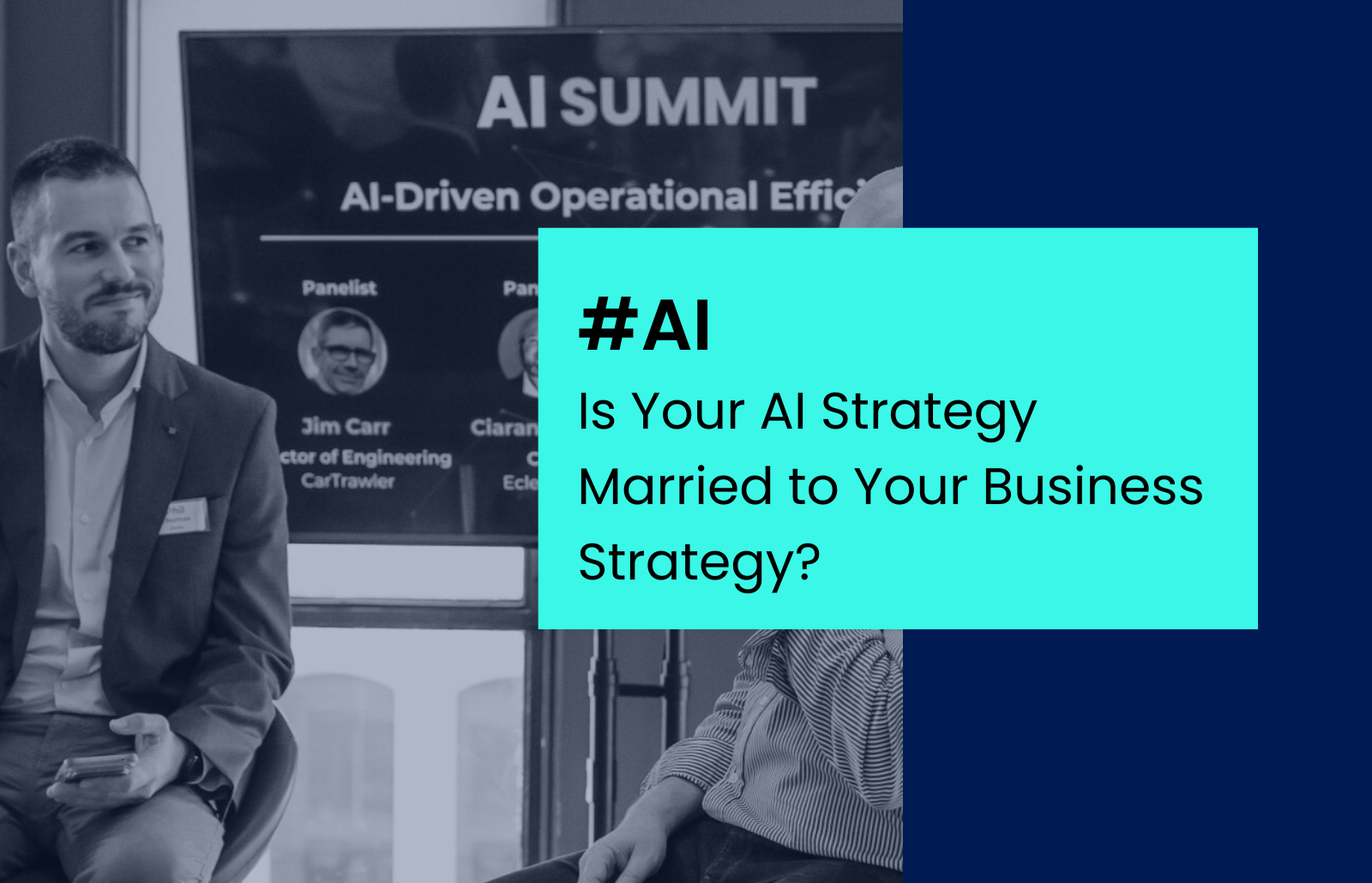Prologue: Hope Is Not a Strategy
At Zartis, our Tech Leadership Insights Survey (2025) uncovered a striking pattern across industries:
Only 52% of organizations have a dedicated AI budget.
That means nearly half — 48% — are experimenting with artificial intelligence without a formal plan, clear KPIs, or leadership alignment.
This 48% gap reveals something deeper than a missing budget line. It signals a widespread disconnect between AI ambition and business strategy — a growing divide between those treating AI as a technological curiosity and those integrating it as a driver of growth, efficiency, and innovation.
Across our client work and summit conversations, we’ve seen one truth repeat itself: an AI strategy is only effective when it’s married to the business strategy.
Otherwise, organizations end up with tools that don’t scale, pilots that don’t convert, and leadership that stops believing in the promise of AI altogether.
This article explores how leaders can bridge that gap — by aligning AI to organizational purpose, applying a clear “growth vs. efficiency” lens, and translating technical potential into measurable business outcomes that executives understand and support.
Because in 2025, hope is not a strategy. Alignment is.
The Disconnect Between AI Ambition and Business Reality
The AI revolution has created an unprecedented paradox: companies are more enthusiastic about AI than ever before — and yet, most still struggle to turn that enthusiasm into measurable outcomes.
According to our survey, 48% of organizations exploring AI have no dedicated budget or roadmap for it. They are, in essence, running on optimism.
This lack of structure mirrors a broader industry problem. BCG’s 2024 report found that only 11% of organizations have achieved significant business impact from AI, despite nearly all reporting active initiatives. The gap isn’t technical — it’s strategic.
Many leadership teams approve AI pilots because they feel they “should.” The pressure to appear innovative is immense. But without a clear link to the company’s core mission or KPIs, those initiatives often become expensive experiments that quietly fade out.
As one of our research participants put it, “We have AI projects, but no AI strategy.”
AI’s allure has made it the centerpiece of every board conversation — but often without the same strategic discipline applied to sales, operations, or finance.
AI projects are greenlit on potential rather than purpose.
The result?
A growing population of companies with impressive demos, no deployment plan, and no measurable ROI.
AI without a business strategy is like a GPS without a destination — sophisticated, but going nowhere.
Defining the Marriage: What It Means to Align AI and Business Strategy
When we talk about “marrying” AI to business strategy, we’re not talking about simply integrating AI into workflows. We’re talking about strategic compatibility — where AI directly supports the company’s competitive positioning, financial goals, and customer promise.
Every AI initiative should answer three fundamental questions:
1️⃣ Why does this matter to our business?
Does it increase revenue, reduce cost, improve customer satisfaction, or open new opportunities?
2️⃣ How will we measure success?
What specific business metrics — not technical benchmarks — will prove its value?
3️⃣ Who owns it?
Is this led by IT, product, operations, or a cross-functional team accountable to the executive suite?
Harvard Business Review (2023) found that organizations that embed AI within their corporate strategy — not their tech strategy — outperform peers on profitability by over 35%. Alignment is not a buzzword; it’s a measurable advantage.
In our experience, when AI and business strategies are aligned, two things happen:
- The ROI of AI becomes visible because it’s tracked against existing business metrics.
- The organization stays focused, avoiding distractions from shiny new tools that don’t move the needle.
An effective AI strategy doesn’t live in the IT department — it lives in the boardroom.
AI for Growth vs. AI for Efficiency: A Strategic Lens for Prioritization
One of the most practical ways to align AI with your business strategy is to classify every initiative under one of two lenses: AI for Efficiency or AI for Growth.
Both are valid. Both are essential. But they serve very different purposes — and require different leadership mindsets.
AI for Efficiency focuses on optimization: reducing manual effort, cutting costs, improving accuracy, and increasing operational speed. Think process automation, customer support chatbots, or data summarization tools.
AI for Growth, on the other hand, focuses on expansion: enabling new revenue streams, launching innovative products, or opening new markets. It’s about using AI to unlock possibilities that didn’t exist before — not just doing existing work faster.
According to Deloitte Insights (2024), 61% of AI budgets are currently directed toward efficiency use cases. These projects often deliver quick, predictable wins — a sensible starting point. But Deloitte also found that growth-oriented AI initiatives deliver three times higher long-term ROI, because they fuel differentiation, not just savings.
The right question for leaders isn’t, “What’s our AI strategy?”
It’s, “What kind of AI strategy are we pursuing — for growth or for efficiency?”
Efficiency keeps you competitive. Growth makes you indispensable.
The “Jobs-to-be-Done” Mindset: How to Build AI That Actually Delivers
Too often, organizations start with what the technology can do instead of what the customer or business truly needs.
That’s where the Jobs-to-be-Done (JTBD) framework comes in. Originally developed by innovation theorist Clayton Christensen, it reframes the conversation from capability to purpose.
In AI, the JTBD mindset means asking not “What can this model do?” but “What job are we hiring this AI to perform?”
When organizations apply JTBD thinking, they uncover the real “jobs” behind their AI ambitions — such as:
- Helping users make better decisions (decision support systems).
- Reducing operational risk (predictive monitoring, fraud detection).
- Personalizing experiences (recommendation systems).
- Freeing employee time for creative or strategic work (process automation).
McKinsey & Company’s 2023 report found that AI initiatives tied to a specific business “job” — such as improving lead conversion or shortening service response times — are twice as likely to reach production and deliver positive ROI.
To apply this in practice, leaders should follow three steps:
1️⃣ Identify unmet needs: What tasks frustrate customers or employees the most?
2️⃣ Map AI to business outcomes: Link each AI capability to a quantifiable metric.
3️⃣ Pilot with intent: Run small, measurable experiments that validate business value before scaling.
The result is AI that’s not only intelligent — but relevant.
Don’t build what’s possible. Build what’s valuable.
Bridging the 48% Gap: From AI Hope to AI Maturity
Why do so many organizations stay stuck in the experimentation phase?
Our survey data points to three recurring challenges:
- Unclear ownership: AI lives everywhere and nowhere — split between IT, product, and innovation teams.
- Fragmented budgets: Funding is reactive, not strategic.
- Lack of measurement: Success is judged by technical performance, not business impact.
These challenges keep organizations in what we call the AI hope zone — a state of enthusiasm without execution.
To move toward maturity, leaders need to shift from projects to portfolios — connecting individual AI efforts to the broader business roadmap.
Here’s how organizations can start bridging the gap:
- Create a cross-functional AI steering group that includes commercial, product, and technical leaders.
- Assign ownership at the business-unit level, not just IT.
- Tie every AI project to a business metric — whether that’s revenue per customer, margin improvement, or satisfaction scores.
- Reframe success criteria from “model accuracy” to “measurable impact.”
Accenture’s 2024 AI Transformation Study found that companies measuring AI success through business metrics are 3.4x more likely to scale their initiatives successfully.
AI maturity begins when success moves out of the lab and into the ledger.
Winning Leadership Buy-In: Turning AI Language Into Business Language
No AI initiative scales without leadership support — and leadership support comes from clarity, not complexity.
In our advisory work, we often see brilliant technical proposals fail to gain traction because they’re written in AI language, not business language.
Executives don’t need to know how the model works. They need to know how it moves the numbers.
To win leadership buy-in, translate AI outcomes into metrics your stakeholders already care about:
- Productivity: “We’ll reduce manual reporting time by 40%.”
- Revenue: “We’ll increase conversion rates by 10%.”
- Cost: “We’ll automate tasks that save €2M annually.”
- Customer experience: “We’ll cut average response time in half.”
Every AI proposal should have a business owner, a financial model, and a timeline for tangible results.
A simple communication checklist for AI leaders:
1️⃣ Define the business problem, not the algorithm.
2️⃣ Quantify expected outcomes in measurable terms.
3️⃣ Set realistic delivery phases that balance innovation with accountability.
4️⃣ Keep messaging simple and outcome-focused.
The fastest way to get leadership buy-in for AI is to stop talking about AI.
From AI Hype to Strategic Harmony: The Zartis Perspective
The lesson is clear: AI success isn’t determined by who has the most advanced technology — it’s determined by who has the most aligned strategy.
BCG’s 2024 report found that organizations aligning AI investments directly with business objectives are six times more likely to achieve measurable financial impact. That alignment doesn’t happen by accident; it’s the result of clear intent, disciplined frameworks, and leadership accountability.
At Zartis, we believe the AI revolution isn’t about technology adoption. It’s about strategic integration — weaving AI into the fabric of business decisions, customer experiences, and growth ambitions.
The future will belong to organizations that treat AI not as a standalone initiative, but as a lens for every business decision.
As one of our advisors often says:
“Technology alone doesn’t transform companies — strategy does.”
The future of AI isn’t about doing more with machines.
It’s about doing better with purpose.
References
- Zartis Tech Leadership Insights Survey (2025)
- Harvard Business Review (2023). Aligning AI with Organizational Strategy
- Deloitte Insights (2024). AI for Growth vs. Efficiency
- McKinsey & Company (2023). Linking AI to Core KPIs
- Accenture (2024). AI Maturity and Leadership Alignment Study.

